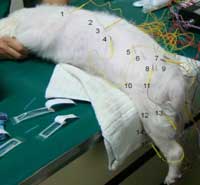A new veterinary case study demonstrates that acupuncture is effective in the treatment of intervertebral disc disease of the thoracolumbar area (mid to lower back). A detailed study of a four year old male Pekingese dog’s experience with acupuncture shows the important benefits of acupuncture in an integrated medical environment. The dog presented with severe hind limb ataxia, atrophy and paresis (impaired movement). A physical exam, computer tomography and a neurological assessment indicated “multiple thoracolumbar intervertebral disc disease (IVDD) throughout the thoracic and cranial lumbar spine.”
Failed Conventional Treatment
Initially, the dog received conventional steroid medication: a high dose therapeutic regime of prednisolone, methylprednisolone sodium succinate, and furosemide. Medication also included spironolactone and ursodexoycholic acid. No significant improvements were documented as a result of the drug therapy.
Acupuncture Treatment
Next, the dog was treated with electroacupuncture (EA) combined with Chinese herbal medicine for a period of six months. As a result of the acupuncture and herbal medicine therapy, the dog showed significant improvement in spinal posture, proprioception, and mobility. The acupuncture points used were UB18, UB22, UB23, UB25, UB26, UB27, UB28, UB37, UB60, GB30, GB31, GB34, Du14, St36, and K1. Electroacupuncture was set to pairs of points at 30 Hz for 10 minutes followed by 80-120 Hz for another 10 minutes. In addition, vitamin B12 was injected into acupuncture points UB23, GB30, St36 and K1. The dog received electroacupuncture twice weekly for a period of one month followed by electroacupuncture once every two weeks for five months. The herbal formula Du Huo Ji Sheng Tang was administered for 6 months in a semi-solid form mixed with honey. Additional care included swimming. In this procedure, the dog was placed in a bathtub twice a week for 20 minutes while the owner stabilized the dog. The dog was encouraged to swim with the feet “barely” touching the bottom of the bathtub. Other additional care included vitamins and supplements including: omega-3 oils, vitamin E, vitamin B complex, glucosamine and chondroitin sulfate.
Results
The dog improved with a “restoration of normal walk, defecation and urination” as measured after six months of therapy. The back pain was measured to have completely resolved and proprioception normalized. The ambulatory parapesis condition improved and the thoracolumbar disc disease decreased from a level V to a level II.

Reference:
Kim SH, NS Kim, KC Lee, HB Lee and MS Kim, 2012. Treatment of multiple thoracolumbarintervertebral disc disease using electro-acupuncture and oriental herbal medicine in a dog. Pak Vet J, xx(x): xxx. Department of Veterinary Surgery, College of Veterinary Medicine, Chonbuk National University, Jeonju, Korea.

